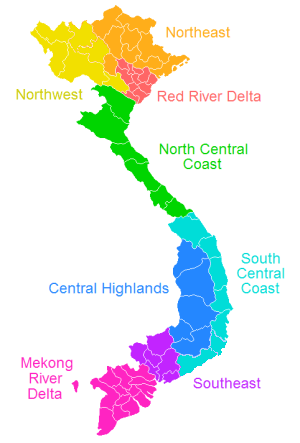Central Vietnam
Central Vietnam (Vietnamese: Trung Bộ or miền Trung), also known as Middle Vietnam or The Middle, formerly known as Trung Phần by South Vietnam, Trung Kỳ and Annam under French Indochina, is one of the three geographical regions within Vietnam.

The name Trung Bộ was used by the king Bảo Đại when he established administrative level higher than Province in 1945, instead of the Trung Kỳ which recalled the French occupation. This name was officially used by government of the Democratic Republic of Vietnam and is popularly used today.
Administration
Central Vietnam includes 3 administrative regions, which in turn comprises 19 First Tier units.
| Administrative Region | First Tier Administrative Units | Area (km²) | Population (2019)[1] | Population Density (people/ km²) |
Notes |
|---|---|---|---|---|---|
| North Central Coast (Bắc Trung Bộ) |
Hà Tĩnh |
51,455.60 | 12,251,864 | 203.53 | contains the coastal provinces in the northern half of Vietnam's narrow central part. They all stretch from the coast in the east to Laos in the west. |
| South Central Coast (Duyên hải Nam Trung Bộ) |
Bình Định |
44,376.80 | 10,934,533 | 206.98 | contains the coastal provinces in the southern half of Vietnam's central part. One province borders Laos. |
| Central Highlands (Tây Nguyên) | 54,641.00 | 6,244,582 | 102.63 | contains the mountainous provinces to the west of south-central Vietnam. There are a significant number of ethnic minorities in the region. One province is along Vietnam's border with Laos, and four border Cambodia (Kon Tum borders both Laos and Cambodia). |
^† Municipality (thành phố trực thuộc trung ương)
Of all 19 First Tier units, 1 is municipality and 18 are provinces.
References
- General Statistics Office (2017): Statistical Yearbook of Vietnam 2015. Statistical Publishing House, Hanoi